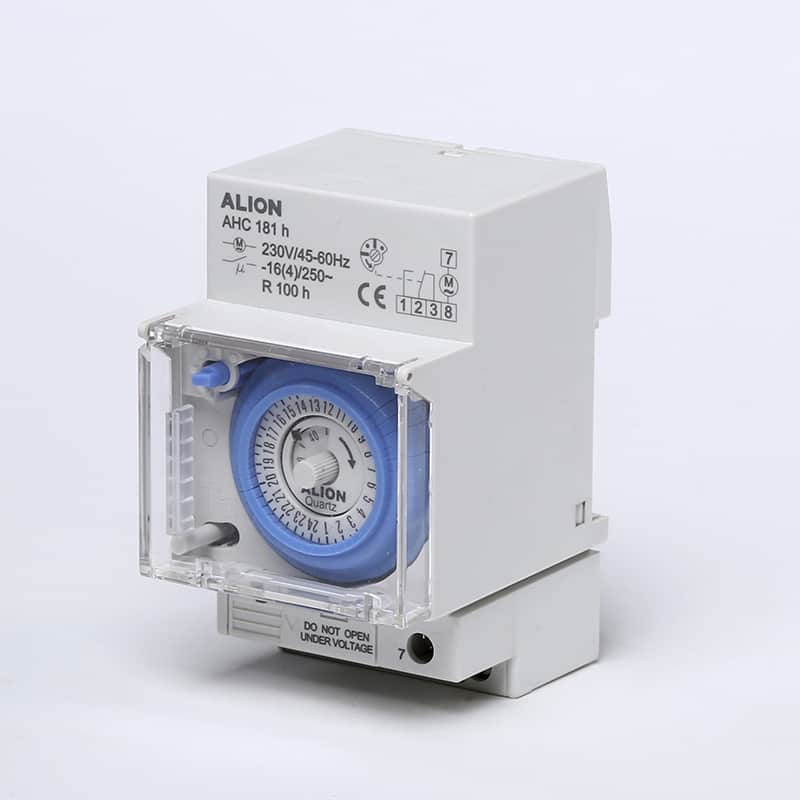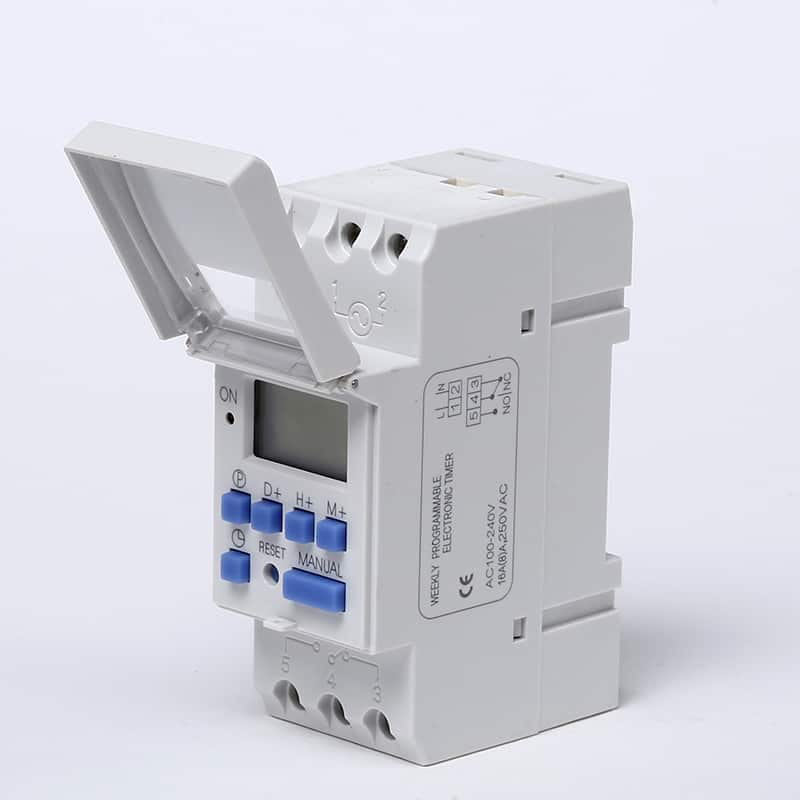Timer switches are tools you can’t do without if you want to automate various tasks in your homes and businesses. They provide convenience, energy efficiency, and enhanced security.
The choice between mechanical and digital timer switches is a crucial decision for anyone seeking to automate tasks. Each type offers distinct advantages and disadvantages, making it essential to understand their unique characteristics before making a selection.
This comprehensive guide will delve deep into the world of mechanical and digital timer switches. We’ll explore their mechanisms, applications, benefits, drawbacks, and key differences to help you choose the one tailored to your specific needs.
What Are Mechanical Timer Switches?

-
Definition and Basic Mechanism
What are mechanical timer switches? Mechanical timer switches are traditional timekeeping devices that operate using a simple yet ingenious clockwork mechanism. They have been relied upon for generations.
At their core is a dial or series of pins that are manually set to determine the on/off schedule. As the internal clock progresses, driven by gears and springs, it triggers a switch to activate or deactivate the connected electrical circuit at the designated times.
How do mechanical timer switches work? The underlying mechanism of a mechanical timer switch is relatively straightforward.
The user sets the desired on/off times by rotating the dial or positioning the pins. The dial is divided into segments, often representing hours or fractions of hours, with markings to indicate the precise time. Each pin corresponds to a specific time slot.
As the internal clock advances, a lever or cam connected to the dial or pins engages with the switch mechanism, causing it to open or close the circuit. This action turns the connected appliance or device on or off according to the preset schedule.
-
Applications of Mechanical Timer Switches
Mechanical timer switches have found widespread use in various applications due to their simplicity, affordability, and reliability. One of their most common uses is controlling outdoor lighting. By setting the timer to turn lights on at dusk and off at dawn, homeowners and businesses can enhance security, deter crime, and conserve energy.
Mechanical timers are also used for indoor lighting, allowing for automated control of lamps, ceiling fixtures, or decorative lighting. This can be particularly useful for creating the illusion of occupancy while away from home or for energy management purposes.
Appliances such as fans, heaters, and air conditioners can also be regulated using mechanical timer switches. This can help maintain a comfortable environment while minimizing energy consumption by automatically turning off these devices when they are not needed.
-
Advantages and Disadvantages of Mechanical Timer Switches
Mechanical timer switches offer several advantages that have contributed to their enduring popularity.
First and foremost, they are relatively inexpensive compared to their digital counterparts, making them an attractive option for budget-conscious consumers. They are also widely available in hardware stores and online retailers, ensuring easy access for those seeking a simple timekeeping solution.
Another key advantage of mechanical timer switches is their simplicity. They do not require electricity to operate, relying solely on the mechanical clockwork mechanism. This makes them reliable even during power outages, ensuring that the preset schedule is maintained regardless of external disruptions.
However, mechanical timer switches also have some limitations. One of their main drawbacks is their limited accuracy and precision. The mechanical clockwork mechanism can be prone to slight deviations over time due to wear and tear, leading to minor inconsistencies in the on/off timings.
Another limitation is their lack of advanced features. Mechanical timers typically offer basic on/off scheduling, with limited options for customization. They may not be suitable for complex schedules or applications that require precise timing or multiple on/off cycles throughout the day.
What Are Digital Timer Switches?

What are digital timer switches? Digital timer switches utilize electronic components, microprocessors, and digital displays to set and manage schedules. They offer greater accuracy, precision, and versatility compared to their mechanical counterparts.
-
How Digital Timer Switches Work
Digital timer switches operate using a combination of electronic circuitry and software. The user interface typically consists of buttons or a touchscreen for inputting the desired schedule and a digital display for visualizing the settings.
Internally, a microprocessor acts as the brain of the timer switch, controlling the timing functions. It receives input from the user interface, stores the schedule in memory, and keeps track of time using a highly accurate internal clock.
At the programmed times, the microprocessor sends signals to the switch mechanism, causing it to open or close the electrical circuit, thereby turning the connected appliance or device on or off.
-
Applications of Digital Timer Switches
Digital timer switches have a wide range of applications, thanks to their flexibility and advanced features. They are commonly used for energy management in homes and businesses, allowing for precise control of lighting, heating, cooling, and other appliances. This can lead to significant energy savings by ensuring that devices are only operating when needed.
In security, digital timer switches are used to create the illusion of occupancy in vacant properties. They can randomly turn lights on and off, making it appear as though someone is home, which can deter potential burglars. Some models even offer additional features like astrological timers that adjust the on/off times based on sunrise and sunset.
Digital timer switches also find applications in agriculture, particularly in hydroponic gardening. They are used to automate irrigation cycles, ensure that plants receive water at the optimal times, and control lighting schedules, mimicking natural day-night cycles to promote healthy growth.
Industrial settings also utilize digital timer switches for automating processes, improving efficiency, and ensuring precise timing in manufacturing and production lines.
-
Advantages and Disadvantages of Digital Timer Switches
Digital timer switches offer numerous advantages over their mechanical counterparts. They provide exceptional accuracy and precision. The internal clock is typically based on a quartz crystal oscillator, which is known for its stability and accuracy. This ensures that the on/off timings are consistent and reliable over time.
Digital timer switches also boast greater ease of use. Their intuitive interfaces and digital displays make it simple to set and adjust schedules, even for complex tasks involving multiple on/off cycles throughout the day or week. Many models offer pre-programmed settings for common applications, further simplifying the setup process.
Another significant advantage of digital timers is their versatility and range of features. They offer a plethora of programmable options, allowing users to create highly customized schedules tailored to their specific needs. Features like countdown timers, random start times, and the ability to create different schedules for weekdays and weekends enhance the functionality and usability of digital timer switches.
However, digital timer switches also have some drawbacks. One of the primary disadvantages is their higher cost compared to mechanical timers. The electronic components and advanced features contribute to their increased price, making them a less attractive option for those on a tight budget.
Another potential disadvantage is their reliance on electricity. If a power outage occurs, the timer switch may lose its programming and require resetting once power is restored. However, many models offer battery backup options to mitigate this issue.
Key Differences Between Mechanical and Digital Timer Switches
The table below summarizes the key differences between mechanical and digital timer switches:
| Feature | Mechanical Timer Switch | Digital Timer Switch |
| Mechanism | Clockwork | Electronic |
| Accuracy and Precision | Limited | High |
| Ease of Use | Basic | User-friendly |
| Versatility and Features | Limited | High |
| Cost | Low | High |
| Power Requirement | None | Yes (with backup options) |
Choosing the Right Timer Switch for Your Needs
Selecting the right timer switch requires careful consideration of several factors, including your budget, desired features, and specific applications. If you are seeking a simple, affordable solution for basic on/off scheduling tasks, a mechanical timer switch may suffice.
However, if you prioritize accuracy, precision, ease of use, and a wide range of features, a digital timer switch is the superior choice. Consider factors like the number of on/off settings you require, the complexity of your schedule, and whether you need additional features like randomization or battery backup.
Alion’s Digital Time Switch: The Pinnacle of Timer Switch Technology

For those seeking the pinnacle of timer switch technology, Alion’s digital timer switch stands out as the ultimate solution. Combining cutting-edge features with user-friendly design, Alion’s digital timer switch empowers you to effortlessly automate your home or business.
With its intuitive interface and programmable versatility, Alion’s timer switch allows you to create customized schedules for lights, appliances, and more with ease. Its exceptional accuracy ensures that your routines are followed to the letter, providing peace of mind and precise control. The advanced features, such as randomization, enhance security and deter potential intruders by creating the illusion of occupancy while you’re away.
Whether you’re a homeowner looking to optimize energy usage, a business owner aiming to streamline operations, or a gardening enthusiast seeking to automate plant care, Alion’s digital timer switch offers the reliability, convenience, and innovation you need.
The Future of Time Management
Don’t settle for outdated technology or limited functionality. Upgrade to Alion’s digital timer switch today and experience the future of time management. Visit our website or your nearest retailer to explore the full range of Alion’s innovative products and discover how they can revolutionize the way you control your environment.
Resources:
What is a Timer Switch? (1)
Top 5 Ways to Use Mechanical Timer Switch at Home (2)
What are the advantages and disadvantages of using timers in electrical controls? (3)








